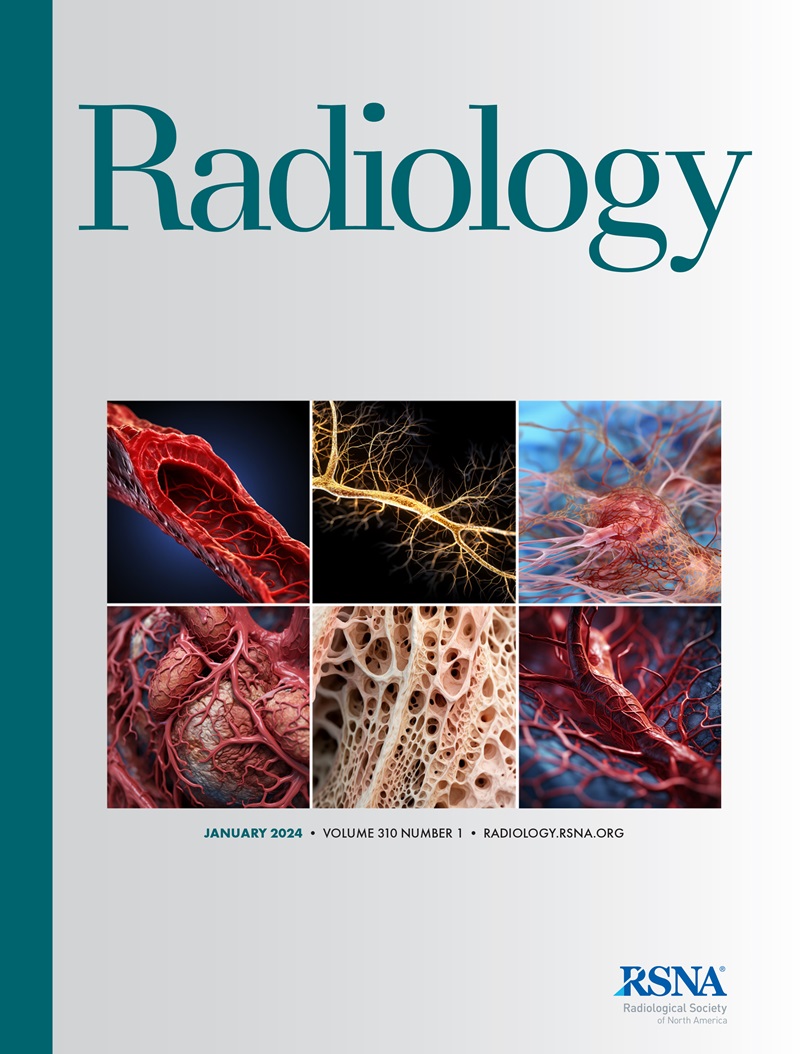Guan-Jie Qin, Wei Jiang, Wu-Qi Zhang, Wen-Fei Li, Gao-Yuan Wang, Yan-Ping Mao, Shun-Xin Wang, Zhe Dong, Yu-Pei Chen, Cheng Xu, Kai-Bin Yang, Yuan Zhang, Ying-Qi Lu, Na Liu, Lei Chen, Rui Guo, Ling-Long Tang, Ying Sun, Ji-Bin Li, Li-Zhi Liu, Xiao-Jing Du, Jun Ma
求助PDF
{"title":"基于mri的N1-N2期鼻咽癌中颈部受累:危险分层的标志。","authors":"Guan-Jie Qin, Wei Jiang, Wu-Qi Zhang, Wen-Fei Li, Gao-Yuan Wang, Yan-Ping Mao, Shun-Xin Wang, Zhe Dong, Yu-Pei Chen, Cheng Xu, Kai-Bin Yang, Yuan Zhang, Ying-Qi Lu, Na Liu, Lei Chen, Rui Guo, Ling-Long Tang, Ying Sun, Ji-Bin Li, Li-Zhi Liu, Xiao-Jing Du, Jun Ma","doi":"10.1148/radiol.243399","DOIUrl":null,"url":null,"abstract":"<p><p>Background The prognostic implications of middle neck involvement, defined as cervical lymph node metastasis between the caudal border of the hyoid bone and the cricoid cartilage, remain unclear in nasopharyngeal carcinoma (NPC). Purpose To investigate the prognostic significance of middle neck involvement in patients with N1 or N2 NPC. Materials and Methods This retrospective analysis included patients with N1 or N2 NPC without distant metastasis treated between April 2009 and December 2017. Patients were categorized according to the presence or absence of middle neck involvement, as determined at MRI. Survival analysis was performed by incorporating TN category and middle neck involvement. Kaplan-Meier curves and the log-rank test were used to compare survival outcomes. Results This study included 9795 patients (mean age, 45 years ± 11 [SD]; 7135 male). Middle neck involvement was identified in 17.0% of patients (1668 of 9795), with prevalence rates of 11.4% (848 of 7429) in the N1 subgroup and 34.7% (820 of 2366) in the N2 subgroup. Multivariable analysis revealed that middle neck involvement was an independent prognostic factor for reduced metastasis-free survival (MFS), overall survival (OS), and disease-free survival (DFS) in both the N1 (all <i>P</i> < .001) and N2 subgroups (<i>P</i> = .001, .02, and .04, respectively). Patients with T1-T2 N1 NPC with middle neck involvement exhibited survival outcomes comparable to those in patients with T1-T2 N2 NPC (all <i>P</i> > .05). Conversely, patients with T3N1 disease without middle neck involvement had better 5-year MFS (91.7% vs 84.6%; <i>P</i> < .001), OS (90.6% vs 84.3%; <i>P</i> = .003), and DFS (83.6% vs 74.4%; <i>P</i> < .001) than those with middle neck involvement. Conclusion Middle neck involvement serves as a critical factor for risk stratification in N1 and N2 NPC. It helps identify patients at high risk within the T1-T2 N1 subgroup and those with T3N1 disease. © RSNA, 2025 <i>Supplemental material is available for this article.</i> See also the editorial by Jabehdar Maralani and Kang in this issue.</p>","PeriodicalId":20896,"journal":{"name":"Radiology","volume":"316 2","pages":"e243399"},"PeriodicalIF":15.2000,"publicationDate":"2025-08-01","publicationTypes":"Journal Article","fieldsOfStudy":null,"isOpenAccess":false,"openAccessPdf":"","citationCount":"0","resultStr":"{\"title\":\"MRI-based Middle Neck Involvement in Stage N1-N2 Nasopharyngeal Carcinoma: A Marker for Risk Stratification.\",\"authors\":\"Guan-Jie Qin, Wei Jiang, Wu-Qi Zhang, Wen-Fei Li, Gao-Yuan Wang, Yan-Ping Mao, Shun-Xin Wang, Zhe Dong, Yu-Pei Chen, Cheng Xu, Kai-Bin Yang, Yuan Zhang, Ying-Qi Lu, Na Liu, Lei Chen, Rui Guo, Ling-Long Tang, Ying Sun, Ji-Bin Li, Li-Zhi Liu, Xiao-Jing Du, Jun Ma\",\"doi\":\"10.1148/radiol.243399\",\"DOIUrl\":null,\"url\":null,\"abstract\":\"<p><p>Background The prognostic implications of middle neck involvement, defined as cervical lymph node metastasis between the caudal border of the hyoid bone and the cricoid cartilage, remain unclear in nasopharyngeal carcinoma (NPC). Purpose To investigate the prognostic significance of middle neck involvement in patients with N1 or N2 NPC. Materials and Methods This retrospective analysis included patients with N1 or N2 NPC without distant metastasis treated between April 2009 and December 2017. Patients were categorized according to the presence or absence of middle neck involvement, as determined at MRI. Survival analysis was performed by incorporating TN category and middle neck involvement. Kaplan-Meier curves and the log-rank test were used to compare survival outcomes. Results This study included 9795 patients (mean age, 45 years ± 11 [SD]; 7135 male). Middle neck involvement was identified in 17.0% of patients (1668 of 9795), with prevalence rates of 11.4% (848 of 7429) in the N1 subgroup and 34.7% (820 of 2366) in the N2 subgroup. Multivariable analysis revealed that middle neck involvement was an independent prognostic factor for reduced metastasis-free survival (MFS), overall survival (OS), and disease-free survival (DFS) in both the N1 (all <i>P</i> < .001) and N2 subgroups (<i>P</i> = .001, .02, and .04, respectively). Patients with T1-T2 N1 NPC with middle neck involvement exhibited survival outcomes comparable to those in patients with T1-T2 N2 NPC (all <i>P</i> > .05). Conversely, patients with T3N1 disease without middle neck involvement had better 5-year MFS (91.7% vs 84.6%; <i>P</i> < .001), OS (90.6% vs 84.3%; <i>P</i> = .003), and DFS (83.6% vs 74.4%; <i>P</i> < .001) than those with middle neck involvement. Conclusion Middle neck involvement serves as a critical factor for risk stratification in N1 and N2 NPC. It helps identify patients at high risk within the T1-T2 N1 subgroup and those with T3N1 disease. © RSNA, 2025 <i>Supplemental material is available for this article.</i> See also the editorial by Jabehdar Maralani and Kang in this issue.</p>\",\"PeriodicalId\":20896,\"journal\":{\"name\":\"Radiology\",\"volume\":\"316 2\",\"pages\":\"e243399\"},\"PeriodicalIF\":15.2000,\"publicationDate\":\"2025-08-01\",\"publicationTypes\":\"Journal Article\",\"fieldsOfStudy\":null,\"isOpenAccess\":false,\"openAccessPdf\":\"\",\"citationCount\":\"0\",\"resultStr\":null,\"platform\":\"Semanticscholar\",\"paperid\":null,\"PeriodicalName\":\"Radiology\",\"FirstCategoryId\":\"3\",\"ListUrlMain\":\"https://doi.org/10.1148/radiol.243399\",\"RegionNum\":1,\"RegionCategory\":\"医学\",\"ArticlePicture\":[],\"TitleCN\":null,\"AbstractTextCN\":null,\"PMCID\":null,\"EPubDate\":\"\",\"PubModel\":\"\",\"JCR\":\"Q1\",\"JCRName\":\"RADIOLOGY, NUCLEAR MEDICINE & MEDICAL IMAGING\",\"Score\":null,\"Total\":0}","platform":"Semanticscholar","paperid":null,"PeriodicalName":"Radiology","FirstCategoryId":"3","ListUrlMain":"https://doi.org/10.1148/radiol.243399","RegionNum":1,"RegionCategory":"医学","ArticlePicture":[],"TitleCN":null,"AbstractTextCN":null,"PMCID":null,"EPubDate":"","PubModel":"","JCR":"Q1","JCRName":"RADIOLOGY, NUCLEAR MEDICINE & MEDICAL IMAGING","Score":null,"Total":0}
引用次数: 0
引用
批量引用

 求助内容:
求助内容: 应助结果提醒方式:
应助结果提醒方式:


